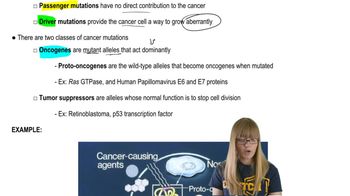Table of contents
- 1. Introduction to Genetics51m
- 2. Mendel's Laws of Inheritance3h 37m
- 3. Extensions to Mendelian Inheritance2h 41m
- 4. Genetic Mapping and Linkage2h 28m
- 5. Genetics of Bacteria and Viruses1h 21m
- 6. Chromosomal Variation1h 48m
- 7. DNA and Chromosome Structure56m
- 8. DNA Replication1h 10m
- 9. Mitosis and Meiosis1h 34m
- 10. Transcription1h 0m
- 11. Translation58m
- 12. Gene Regulation in Prokaryotes1h 19m
- 13. Gene Regulation in Eukaryotes44m
- 14. Genetic Control of Development44m
- 15. Genomes and Genomics1h 50m
- 16. Transposable Elements47m
- 17. Mutation, Repair, and Recombination1h 6m
- 18. Molecular Genetic Tools19m
- 19. Cancer Genetics29m
- 20. Quantitative Genetics1h 26m
- 21. Population Genetics50m
- 22. Evolutionary Genetics29m
19. Cancer Genetics
Cancer Mutations
Problem 30
Textbook Question
Textbook QuestionAlthough cancer is not a contagious disease in humans or other vertebrates, there have been rare cases in which cancers have spread from one organism to another. Describe three cases of these contagious cancers and what conditions might have led to their appearance. For an introduction to this topic, see http://www.cancer.org/cancer/cancerbasics/is-cancer-contagious.
 Verified Solution
Verified SolutionThis video solution was recommended by our tutors as helpful for the problem above
Video duration:
2mPlay a video:
Was this helpful?
Key Concepts
Here are the essential concepts you must grasp in order to answer the question correctly.
Contagious Cancers
Contagious cancers are rare instances where cancer cells can be transmitted from one individual to another, leading to the development of tumors in the recipient. This phenomenon has been documented in certain species, such as Tasmanian devils and dogs, where cancer cells can spread through direct contact or environmental exposure. Understanding these cases helps illustrate the unique biology of cancer and its potential for transmission under specific conditions.
Recommended video:
Guided course

Cancer Characteristics
Environmental Factors
Environmental factors play a crucial role in the emergence of contagious cancers. For instance, close living conditions, social behaviors, and shared habitats can facilitate the transfer of cancer cells between individuals. In the case of Tasmanian devils, aggressive behaviors during mating rituals have been linked to the spread of facial tumor disease, highlighting how ecological and behavioral contexts can influence cancer transmission.
Recommended video:
Guided course

F Factor and Hfr
Immune System Evasion
The ability of cancer cells to evade the immune system is a key factor in the development of contagious cancers. Normally, the immune system identifies and destroys foreign cells, but in some cases, cancer cells can develop mechanisms to avoid detection. This evasion allows them to survive and proliferate in a new host, as seen in the transmissible venereal tumor in dogs, where the cancer cells are recognized as 'self' by the recipient's immune system.
Recommended video:
Guided course

Non-Random Mating

 4:50m
4:50mWatch next
Master Cancer Mutations with a bite sized video explanation from Kylia Goodner
Start learningRelated Videos
Related Practice


